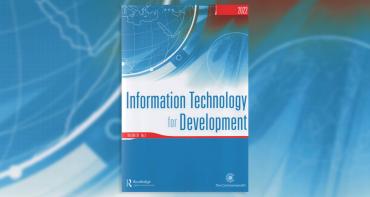A blog by Attila Shaaran, Economic Research Officer in Economic Policy and Small States at the Commonwealth Secretariat.

Commonwealth countries possess a remarkable diversity. From countries with large economies to developing nations and small states facing the brunt of climate change and economic vulnerability. This economic disparity is starkly reflected in tax revenue, the lifeblood of any government. Tax revenue fuels essential services, public infrastructure, and social programmes. For Commonwealth countries, particularly small states, this financial wellspring is particularly vital as it allows them to invest in climate-resilient infrastructure.
Moreover, a healthy tax base empowers these nations to pursue the Sustainable Development Goals (SDGs), a shared vision for a more equitable and sustainable future. In this blog, we delve into the tax landscape of the Commonwealth small states, analysing the tax-to-GDP ratio across countries, and propose possible ways to boost tax revenue.
Tax revenue trends and disparities in Commonwealth Small States
Both the Commonwealth as a whole and Commonwealth small states generate less tax revenue compared to the world average. The average tax revenue as percentage of GDP is 23% for the world, 21% for Commonwealth small states, and 19% for Commonwealth countries.[1] Between 2011 and 2019, Commonwealth countries managed to increase their tax revenue (as percentage of GDP) by 4.8 percentage points versus the world average of 5.3.
Tax revenue in Commonwealth small states increased by only 3.9 percentage points between 2011 and 2019. In addition, Commonwealth small states suffered the highest decline in tax revenue during the Covid-19 pandemic. Between 2019 and 2021, Commonwealth small states’ tax revenue as percentage of GDP decreased by 6.4 percentage points, compared to a decline of 1.4 for the Commonwealth countries and a decline of 0.7 for the world average.

Tax revenue in Commonwealth small states presents a mixed picture. Between 2011 and 2019, several Commonwealth small states, such as the Maldives, Guyana, Eswatini, and the Bahamas, saw significant improvements in their tax revenue generation. The Maldives led the way with the highest increase in tax revenue by 58%, followed by Guyana with a 42% rise, Eswatini with 31%, and the Bahamas with 28%.
However, not all Commonwealth small states experienced growth. Several countries, including Papua New Guinea, Trinidad and Tobago, and Botswana, saw reductions in their tax revenue during this period. Papua New Guinea's decline was the steepest at 32%, followed by Trinidad and Tobago at 15%, and Botswana at 14%. Additionally, some countries, like Vanuatu, Seychelles, and Fiji, saw little changes in their tax revenue during this period.

COVID-19's impact: Severe tax revenue decline in small states
Tax revenue in Commonwealth small states was significantly impacted during the COVID-19 era, underscoring the vulnerability of these nations to external shocks. While some countries managed to increase their tax revenue, most Commonwealth small states experienced significant reductions between 2019 and 2021. Vanuatu's tax-to-GDP ratio witnessed the steepest decline at 36%, followed by Fiji at 32% and Guyana at 27%.
This further reinforces the argument that small states are highly susceptible to economic and climate shocks. Their dependence on a limited number of sectors, such as tourism, trade, and diaspora investment (remittances), exacerbates their ability to generate more tax and strengthen their resilience.

Strategies for boosting tax revenue and resilience
Higher tax revenue is crucial for Commonwealth small states. Otherwise, they would struggle to fund essential services and achieve SDGs, while social programmes and economic growth may also suffer. However, raising taxes is tricky, as it could discourage investment. The key is finding a balance between enough revenue and a business-friendly environment. There's room for improvement, especially for commodity exporters with low tax effort, and technology can help collect taxes more efficiently. In some cases, VAT rate increases might be considered.
Small states tend to have lower VAT rates, averaging around 14%; 2% below the average for Emerging Market and Developing Economies. This difference suggests the potential for these countries to raise tax revenue by increasing VAT rates, similar to Fiji's 2023 policy. In Fiji, the VAT rate went from 9% to 15%, with essential items remaining exempt (World Bank, 2024). Well-designed, implemented, and enforced VAT systems can be significant revenue generators. Compared to income and trade taxes, VAT is often considered a more efficient option.
While strong tax administration is crucial for tax collection, small states often face challenges due to organisational inefficiencies, outdated systems, and limited resources. Digital technologies can come handy in transforming tax administration in Commonwealth small states. Digital technologies can improve taxpayer experience, optimise internal operations, boost compliance, reduce costs, and increase revenue collection. Digital tools also ease the audit process and fraud detection.
Supporting best practices and enhancing resilience
A strong tax system is vital for Commonwealth countries. The Commonwealth Secretariat is dedicated to assisting member states in building resilient economies. At the 2023 Commonwealth Finance Ministers Meeting, we presented a discussion paper on strengthening domestic resource mobilisation through the introduction of environmental levies such as carbon taxation and taxes on single-use plastics, which was well-received.
This blog was written in close consultation with the Commonwealth Association of Tax Administrators (CATA), and we are committed to working closely with CATA and other relevant organisations to strengthen tax systems across the Commonwealth.
Learn more about our work with small states
[1] To exclude the pandemic era as small states were affected significantly, only the period between 2011 and 2019 was used to calculate the average for these three categories.



